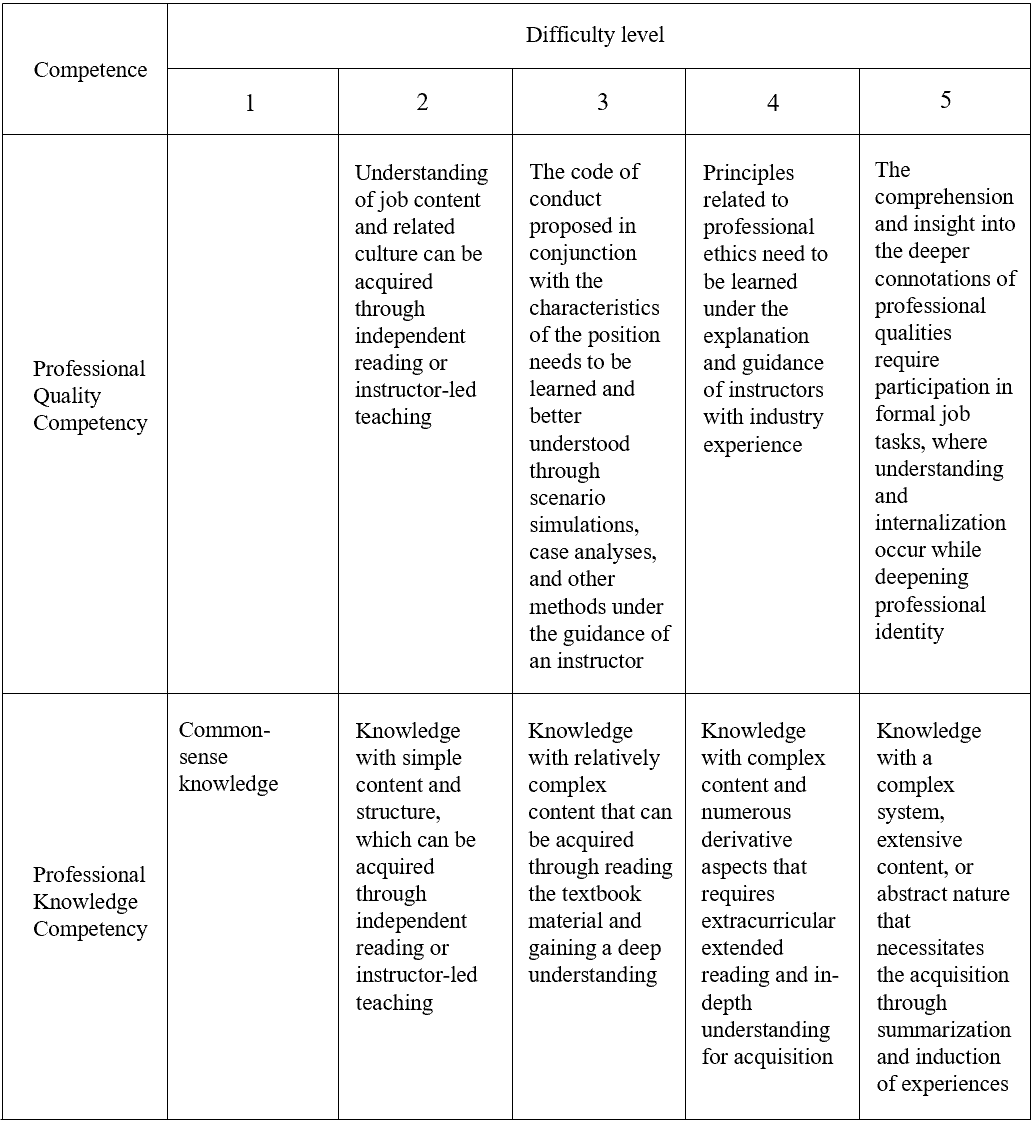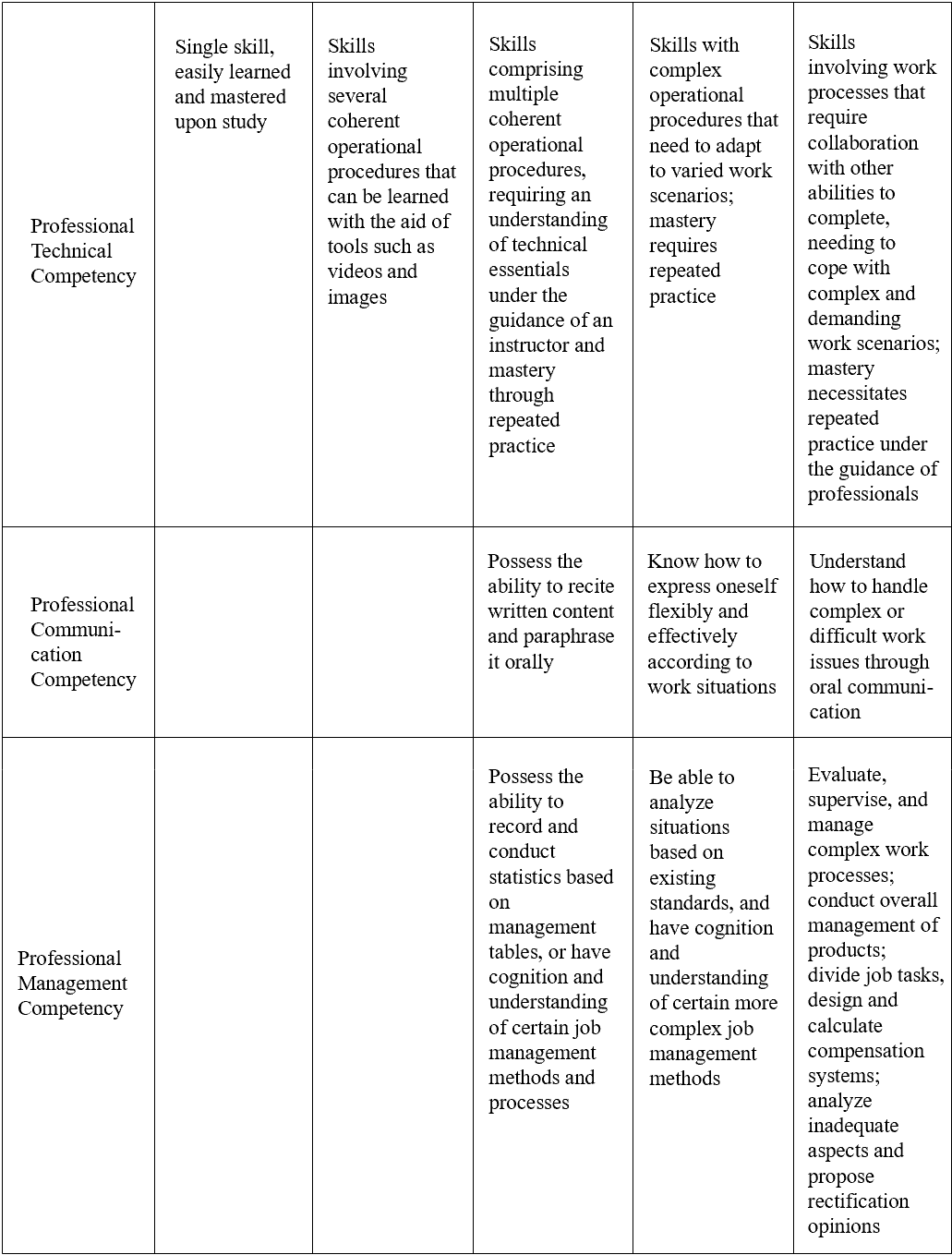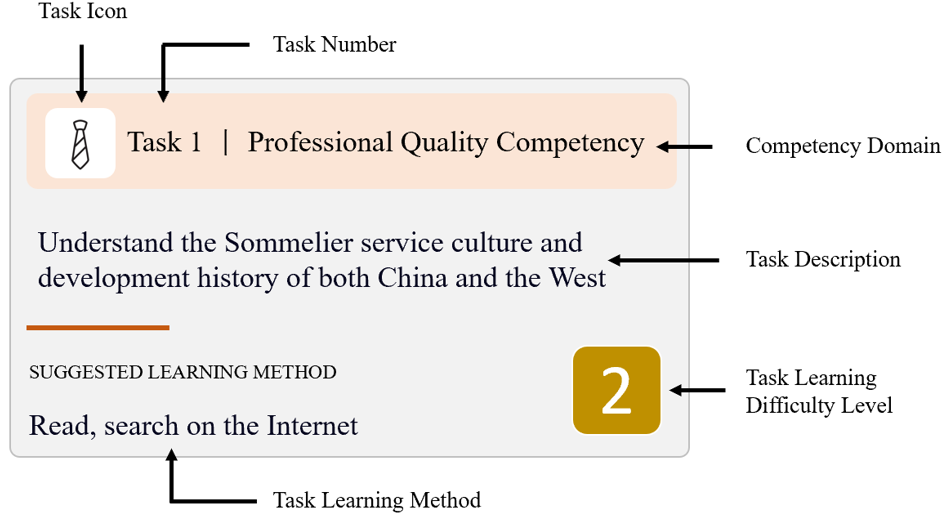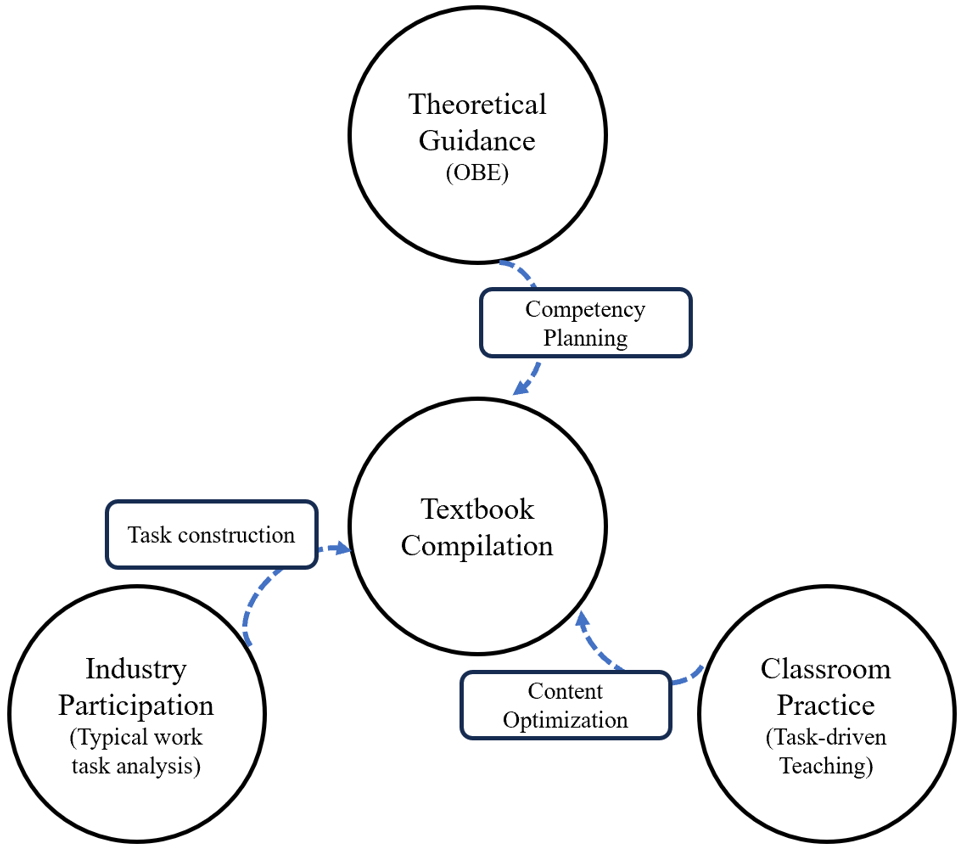Introduction
In 2019, the Ministry of Education emphasized in the Measures for the Administration of Textbooks in Vocational Colleges (Ministry of Education, 2019) that textbook development in vocational colleges should address the relationship between the "common issues" encountered in textbook compilation and the "characteristic development of vocational education." It is necessary to base textbook development on socio-economic development, fully reflect market demands and new technologies and trends in industries, emphasize practicality on the basis of integrating theory and practice, adapt to the requirements of teaching methods such as "task-driven" approaches, and arrange the content in a scientific and reasonable manner. The state continuously emphasizes the importance of textbook construction and its correlation with teaching methods and teachers, aiming to promote and deepen the progress and depth of the "three teachings elements" (teaching materials, teaching methods, and teachers) reform in vocational education and improve the quality of vocational institutions by improving the quality of textbooks.
Currently, a large number of colleges, universities, and institutions across the country are engaged in textbook construction. While significant achievements have been made, there are also urgent issues that need to be addressed. Firstly, there is a lack of scientific top-level design in textbook content and planning, which is manifested in outdated knowledge content, awkward transitions in textbook revisions, and chaotic internal structures (Li & Wang, 2016). Secondly, during the compilation process, there is low industry participation, and problems such as insufficient level of cooperation, lack of motivation, and quality issues exist in school-enterprise cooperation (Pan et al., 2013), leading to practical training content in textbooks lagging behind the current state of industry development, which hinders students' employment and development. Finally, newly compiled textbooks still adhere to the educational philosophy of discipline-based learning, lack interaction with teaching methods, and fail to reflect the characteristic of vocational education of "learning by doing" (Wei, 2012). Based on the above situation, this paper attempts to take the compilation process of the textbook Wine Service and Management (hereinafter referred to as Sommelier Service) as an example to explore how, under the guidance of the "competency-based" theory, the compilers leverage industry participation and classroom practice to improve the structure and content of the textbook. From this, a "Trio-driven" textbook compilation model consisting of "theory guidance," "industry participation," and "classroom verification" is summarized.
Theoretical Framework
Textbook Compilation under the "Competency-Based" Theory
In pedagogy, competence is commonly defined as "the individual psychological traits that can directly affect the efficiency of activities and facilitate their smooth progress." (Guo, 2002) Competence is internalized within individuals and externalized through overt professional activities or behaviors. For vocational education, the cultivation of students' vocational competence is of utmost importance. Over the years, numerous concepts, educational theories, and paradigms centered around competence have emerged. Among them, "Competency-Based Education (CBE)," a global vocational education and training trend that originated in the last century, still has a profound impact on the reform and development of vocational education today (Jiang, 2004).
"Competency-Based Education" refers to an educational teaching philosophy and institutional system based on competence. The concept of competency-based education originated from training for retired and transferred personnel and was widely applied in teacher training in the United States in the 1960s. Subsequently, it has gradually become one of the fundamental paradigms of international vocational education (Liu & Xu, 2002). It is regarded as both a plan for the systematic development of vocational and technical education and a curriculum development or teaching model. With competence as the foundation of teaching, the framework of the curriculum is established based on the instructor's concept of competence and evaluation standards (Jiang, 2004).
People have different understandings of the specific connotation of the concept of "competence" in different regions and historical stages. Common concepts of competence include the "task-based different regions and historical stages. Common concepts of competence include the "task-based competence view," which regards "competence as skills," the "general quality-oriented competence view," which views competence as general qualities, and the "integrated competence view," which considers competence as the sum of knowledge, skills, and attitudes demonstrated by individuals in work performance (Ji, 2005). The "integrated competence view" can avoid the limitations of the first two concepts to some extent. It connects general qualities with specific work contexts and regards competence as a complex quality structure that can be divided into different levels, which is more suitable for the current development of vocational education in China (Tan & Qian, 2001).
In classrooms based on the "integrated competency-based" approach, elements such as teachers, students, and textbooks differ significantly from those in traditional classrooms. Vocational education based on the integrated competence concept focuses on the comprehensive competence of a specific vocational position. It emphasizes students' performance and evaluation standards in real work contexts and designs everything from curriculum objectives to content, activities, and assessments around the question of "what to learn?" Unlike other competency-oriented curricula such as modular skill training and project-based teaching, the comprehensive development-oriented competency-based curriculum is not limited to the "surface structure of individual behavior," such as verbal expression and practical skills. It also emphasizes the "deep structure of individual behavior," including action patterns, thinking modes, and work attitudes that cannot be directly observed (Jiang, 2005). It can be inferred that textbooks guided by the "competency-based" theory are composed of materials from the industry and front-line positions. Compared with traditional textbooks, they meet the actual needs of employers such as enterprises to a great extent (Qin, 2011).
In general, the textbook compilation model under the "competency-based" theory is an organizational process of teaching content that closely adheres to vocational contexts and aims to acquire knowledge and skills at different levels and cultivate vocational qualities. Qualities, knowledge, and skills appear in the form of "tasks" in teaching. However, during the textbook compilation process, questions such as “How to determine tasks?”, “How to classify levels or difficulties?”, and “How to test the appropriateness of the textbook for students and classrooms so that the textbook can serve the classroom/workshop teaching?”, thereby helping to cultivate students' learning interest and improve their technical abilities, are the purposes of this research. In the following sections, this paper will describe the three important stages of compiling the Sommelier Service textbook, revealing how the "competency-based" theory is implemented throughout the entire action process through practical approaches, and thus summarizing an effective textbook compilation model.
Case Background
In 2019, the Ministry of Education included the "Wine Culture and Marketing" (540108) major in the professional directory of the hospitality and tourism category for the first time. Among them, "sommelier service" is defined as the core course of this major. However, there is no professional textbook in the textbook market that is suitable for the teaching of this skill. In addition, not only the newly added "Wine Culture and Marketing" major has a demand for the sommelier service course, but also majors such as "Hotel Management and Digital Operation" (540106), "Homestay Management and Operation" (540107), "Leisure Service and Management" (540113), as well as catering majors like "Culinary Arts and Nutrition" (540202) and "Western Culinary Arts" (540204) have potential needs for offering this course. As an important skill in restaurant service, sommelier service is also an important competition segment in the "Sommelier Service" and “Hospitality Service” events of the National Vocational Students Skills Competition for Higher Vocational Colleges and the "Restaurant Service" event of the World Skills Competition. Driven by the trend of new major construction and actual teaching needs, the compilation team carried out the compilation work for the textbook of the "Sommelier Service and Management" core course.
The chief editor of the textbook has 17 years of experience in the beverage industry, is a national first-class sommelier, a senior technician, and has nearly ten years of teaching experience in wine courses at domestic and international vocational institutions. The second chief editor and the associate editor are teachers from secondary vocational schools, higher vocational colleges, and undergraduate institutions, respectively. The contributing editors also come from vocational colleges at different levels. All the editors have rich practical experience and professional development experience related to wine. They have all obtained domestic and international certifications related to wine by participating in teacher training, have an understanding of industry development, and possess the knowledge and abilities required of "dual-qualified" teachers.
The compilation process of the textbook consists of four stages: 1) Competency Planning Stage, 2) Task Construction Stage, 3) Classroom Practice Stage, and 4) Content Optimization Stage (as shown in Figure 1). Among them, the first three stages are the core stages of textbook compilation.
Figure 1:
The four compiling stages of the Sommelier Service

Competency Planning
Sommelier service education is a blank in China's vocational teaching system. The sommelier service position itself originates from the Western-style restaurant services. "Sommelier Service and Management" is a course designed for students majoring in middle-and high-level vocational institutions and applied undergraduate hospitality and tourism management. It aims to enable students to master rich and solid theoretical knowledge and practical skills, so as to possess the professional qualities and competencies required of a professional sommelier. The course is highly practical and professional. Using the "competency - based" theory as the guiding principle for textbook compilation helps clarify content priorities, organize the textbook framework, and standardize the compilation process, which is in line with the fundamental logic of "cultivating morality and nurturing talents" in vocational education.
Before constructing the initial framework of the textbook, based on the discussions of (Jiang, 2004; Jiang, 2005; Tan & Qian,2001) on the "competency - based" theory, combined with the pre-investigation on sommelier service and beverage management positions in 19 enterprises in China (including 9 five-star hotels and 10 restaurants with Michelin and Black Pearl ratings), the compilation team established five major competency domains: "Professional Quality Competency", "Professional Knowledge Competency", "Professional Technical Competency", "Professional Communication Competency", and "Professional Management Competency". In the textbook instructions, there are clear descriptions for different competencies and their manifestations.
Professional Quality Competency. The "Professional Quality Competency" is described as:
"…includes cultivating students' awareness of the job and position content, understanding the career development path, gaining in - depth knowledge of position - related culture and establishing professional identity, recognizing and implementing the grooming and appearance requirements for the position, and recognizing and abiding by position - related professional ethics."
The description of its "manifestation" is:
"The ability to understand and implement the requirements for the position."
Professional Knowledge Competency. The "Professional Quality Competency" is described as:
“…includes the relevant knowledge reserves required to complete job tasks; this is mainly manifested in the cultivation of reading and memory abilities.”
The description of its "manifestation" is:
“The ability to interpret and remember relevant knowledge.”
Professional Technical Competency. The “Professional Technical Competency” is described as:
“…encompasses the cultivation and training of technical skills required to perform job tasks.” The description of its "manifestation" is:
“The ability to remember technical operation procedures and the operational skills.”
Professional Communication Competency. The “Professional Communication Competency” is described as:
“…includes the ability to communicate with guests, suppliers, and colleagues (both superiors and subordinates) during the process of fulfilling job responsibilities.”
The description of its "manifestation" is:
“Verbal expression ability, comprehension ability, and interpersonal relationship skills regarding professional communication content.”
Professional Management Competency. The “Professional Management Competency” is described as:
“…It includes the abilities to manage human resources, corporate finances, and product management that are required during the process of fulfilling job responsibilities.”
The description of its "manifestation" is:
“The ability to analyze workplace situation, the capability to coordinate and manage people, affairs, and objects, and the capacity to plan work.”
Competency planning guided by vocational education theory ensures that the "particularity of vocational education talent cultivation" is integrated into the top - level design stage of textbook compilation. Industry opinions provide the basis and guidance for the connotation and boundaries of competency planning. The interaction between the two ensures the dual driving forces of theoretical guidance and industry direction.
Task Construction
After completing the planning of "competency domains", the task of the textbook compilation team is to construct corresponding learning tasks within different competency domains. Learning Tasks are the platforms for cultivating competencies. However, how to set these tasks has become the focus of the compilation team's concern, as the chief editor of the textbook said:
"Competency planning provides a skeleton for the textbook, which comes from theory and is also combined with the industry context. However, the connotation of the textbook is the learning tasks that students need to learn. These learning tasks are the work tasks they will undertake in their positions. With this in mind, we decided to continue contacting the cooperating enterprises and sit down with them to gain an in - depth understanding of the specific work tasks in sommelier service and management positions."
“Typical work task analysis” is an activity in which both schools and enterprises participate. They conduct discussions and analyses on the work content, methods, and standards of a certain occupation, in order to comprehensively obtain relevant work tasks and required professional competencies (Zhao, 2008). Currently, social development is so rapid that the work content of all walks of life is constantly changing. How to accurately and timely capture the employment needs of enterprises so that students can better and faster integrate into positions, work, and society is a major challenge we are facing now. “Typical work task analysis”, as a way to study the laws of career development and an effective platform to connect schools and enterprises, has become a breakthrough to solve this problem.
The purpose of holding "Typical work task analysis meeting" for positions is to understand the daily work tasks of personnel in charge of sommelier service and management positions, as well as the competency evaluation standards for engaging in certain vocational skills (such as the sommelier service process and standards for red wine). Each meeting lasts for about 1 hour. The content of the meetings is recorded and transcribed, and the text information is classified and coded.
Finally, the loose task items mentioned by enterprises are summarized into 90 classroom/workshop teaching task items.
The 90 task items summarized from the "Typical work task analysis meeting" are allocated to the five competency - building domains. Each task item has a detailed description. The description of tasks is oriented towards skill - learning "outcome" goals, often using words such as "understand", "master", "identify", and "be able to" as prefixes, for example:
"Be able to present the wine list to guests using common phrases and respond to different reactions of guests after reading the wine list."
The compilers number the tasks (1 - 90) according to the order in which they appear in the textbook, so that teachers and students can refer to them during the interaction process. The formulation of task items clarifies the boundaries of students' skill learning, learning objectives, and evaluation standards, and provides clear guidance for the implementation of classroom/workshop teaching. Task construction based on "Typical work task analysis" is related to the connotation and quality of the textbook. On the one hand, task construction is task construction within the "competency domains" and is task construction guided by the "competency-based education" theory. On the other hand, the process of task construction not only fills and divides the difficulty levels of the "competency domains" but also further verifies the rationality and appropriateness of the formulation of the "competency domains" through industry practice. The two interact with each other and form a driving force to promote the textbook compilation process.
Classroom Practice
After completing the first draft based on the above-mentioned competency domains and task items, the compilation team integrated 90 task items into 48 class hours and carried out classroom teaching practice for second - year students majoring in Hotel Management and Digital Operation in a vocational and technical college. The course was conducted in the training laboratory, with four class hours as one lesson, ensuring the continuity and contextualization of skill learning (Esmond, 2017). The "task-driven" teaching mode takes "problem-solving" and "task completion" as teaching objectives. Its essence is to enable students to learn around tasks and acquire target competencies in the process of completing tasks. This mode fits the process of students' cognitive development, can give full play to students' main role in the classroom/workshop, and develop students' comprehensive abilities (Guo, 2006; Yang, 2006). The competency planned in this textbook and the learning "tasks" constructed can just provide a basis for course design. The characteristics of the textbook with "tasks" as the main body and skill - learning "outcomes" as the goal orientation determine that the "task-driven" teaching mode is the preferred means of teaching implementation.
During the teaching implementation process, each class needs to complete one or more task-based teachings. Task evaluation is oriented towards learning outcomes, with only two assessment modes: "pass" and "fail". Learners who can complete the task under specified conditions (time, context, tools) through task-based learning are considered "pass"; for some skill tasks with specified steps and procedures, if learners do not complete them according to the specified steps, even if they achieve the outcome goal of the task, they will be considered "fail". The teaching process is completed in the training restaurant, providing a real work context for task-based teaching.
Through the classroom/workshop practice of the "task-driven" teaching mode, the compilation team first clarified the knowledge boundaries of each teaching task. By further polishing the learning content of "tasks", teachers can better understand the key and difficult points of teaching, thereby improving classroom efficiency. Secondly, through the "task- driven teaching mode", feedback from students in the process of "task" learning was obtained. Based on the speed at which students master specific tasks, the compilation team made additions and deletions to the relevant learning content to match the teaching content with the learning abilities of higher vocational students. According to student feedback during the classroom teaching process, the compilation team found that even tasks belonging to the same competency domain also have differences in learning difficulty. Therefore, the compilation team divided tasks belonging to the same competency domain into five difficulty levels and provided specific descriptions. For example, the descriptions of the five difficulty levels of "Professional Technical Competency" are:
Level 1: "Single skill, learn and master immediately"
Level 2: "Has several coherent operation processes, can learn with the help of videos, pictures, etc."
Level 3: "Has multiple coherent operation processes, needs to understand technical essentials under the guidance of the teacher and master through multiple practices"
Level 4: "Has complex operation processes, needs to cope with changeable work scenarios. Requires multiple practices to master"
Level 5: "Has work processes that need to be completed in collaboration with other competencies, needs to cope with complex and demanding work scenarios. Requires multiple practices under the guidance of professionals to master"
In Sommelier Service, to facilitate instructors in implementing teaching based on objective conditions and students' learning progress, the author provides difficulty level indications for each capacity-building task (Table 1).
Table 1:
The description of the difficulty level of the competency-building tasks in the book Sommelier Service (Pan, 2021)


In Sommelier service, after elaborating and analyzing the content of each task, the compilators annotate it in the form of a "Task Tag"; The "Task Tag" serves as an instructional aid throughout the textbook. In addition to providing information such as the task category, task description, and task difficulty, the "Task Tag" also offers task learning methods based on the editor's teaching experience for the reference of instructors and students (Figure 2).
Figure 2:
Example of Competency-Building Task Tag (Pan, 2021)

Finally, the "task-driven teaching mode" also stimulated teachers' classroom feedback. From the perspective of teachers, the compilation team collected feedback questions such as: Does the task content have output obstacles in the teaching process? Are the teaching context and equipment conducive to the mastery of "tasks"? Is the description of "tasks" evaluable and measurable? Can teaching auxiliary materials such as PPT and videos truly achieve their teaching auxiliary functions? What methods should be used to distinguish different skills in teaching? What methods should be recommended for students to use for pre-class, in-class, and after-class learning? The collation and reflection of the above-mentioned problems prepared the direction for the revision and optimization of the textbook in the next stage.
By integrating the re-definition of knowledge boundaries obtained from teaching practice and the classroom feedback from students and teachers, the compilation team was able to revise the content and structure of the textbook. In terms of teaching content, further clarifying the description of learning tasks is conducive to students and teachers' better grasp and understanding of "tasks". The second is the optimization of class hour arrangement. During the teaching practice process, the class hours required for the teaching of some tasks were more than expected. Therefore, the original 48 class hours were adjusted to 60 class hours, which is more conducive to the development of various "task" teachings. The third is to improve the "skill assessment" and "thinking and practice" sections after each module. Finally, it is the optimization of teaching auxiliary materials, that is, re-adjusting the teaching tools required in practical training courses, the per-capita allocation quantity, and the placement location, re-designing the structure of teaching PPT, and adding or deleting the extended knowledge in the teacher's auxiliary manual.
"Competencies" are composed of "tasks", and tasks are present throughout the teaching process. Therefore, classroom practice using the "task-driven" teaching mode provides a classroom verification process for textbook compilation under the "competency-based" theory. Both "task-driven" and "competency-based" have obvious outcome-oriented characteristics. The contextual nature of the "task-driven" teaching mode is consistent with the goal connotation of "competency-based". It can be seen that the skill-teaching tasks within the "competency domains" provide the basis and scope for course design and course practice. And classroom teaching with the "task - oriented" mode plays a role in testing and optimizing the construction of "tasks" in the textbook.
Summary
By analyzing the compilation process of the Sommelier Service, this case summarized a compilation mode consisting of three core driving forces: "Theoretical Guidance", "Industry Participation", and "Classroom Practice", referred to as the "Trio-Drive" compilation mode. In this case, each of the three driving forces has specific manifestations and implementation methods. It takes the discussion of the "competency-based education" theory in vocational education as the basis for "theoretical guidance", "Typical work task analysis" as the means of "enterprise participation" and "industry guidance", and the "task-driven" teaching mode as the means of "classroom practice" verification, finally forming a systematic and replicable textbook compilation mode (Figure 3). Under the guidance of the "competency-based education" theory, the compilation team completed the planning of "competency domains" and used it as the general guideline to guide the entire process of textbook compilation. "Position typical work task analysis" fully incorporates the opinions and suggestions of enterprises on talent cultivation. By "task items" in job operations, the connotation of "competency" is improved. The "task-driven" teaching mode plays a role in revising and optimizing the "task items" of the textbook in practical training classrooms. From the above analysis, it can be seen that the three driving forces each have an independent driving effect on textbook compilation.
Figure 3:
“Trio-Drive" Dynamic Textbook Compilation Model

However, the three driving forces are not isolated from each other. On the contrary, they interact with one another. Between theory and corporate involvement, theory provides direction for enterprises in planning "employee competencies," ensuring that this direction aligns both with the practical needs of job positions and the principles of vocational education talent cultivation. Corporate involvement, in turn, helps educational theories become more focused on industry realities, making them more practical. Between theory and classroom practice, theory ensures that classroom implementation closely follows the direction of talent cultivation, setting students' "competency building" as the goal of classroom teaching.
Feedback from teachers and students in the classroom then tests the "competency domains" established under theoretical guidance. Finally, between corporate involvement and classroom practice, corporate involvement enriches classroom teaching with content that meets job requirements, while the classroom, through teacher and student feedback, defines boundaries, categorizes difficulty levels, and plans teaching progress for this content. Thus, textbook compilation under the "Trio-drive" model is not a linear process with a clear start and end but rather a cyclical process within a closed loop. This indicates that the content of textbooks will change under the influence of any of the driving forces. These changes may stem from the vocational education sector's redefinition and understanding of "competency-based education" theory, from the latest changes in industry job requirements, or from daily classroom feedback. Therefore, textbook compilation under the "Trio-drive" model is a dynamic process that fully meets the requirements for vocational education textbooks to keep pace with the times, suit industry development, and align with the laws of vocational education development.
Discussion
The design of the "Trio-drive" dynamic textbook compilation model originates from reflections on the current state of vocational education textbook development. While constructing this model, there are also many reflections on practical conditions.
Firstly, under the "Trio-drive" model, high levels of corporate and industry involvement enhance the relevance of textbooks. However, this presupposes a close school-enterprise cooperation mechanism. For a long time, issues such as the absence, incomplete participation, and lack of depth in corporate and industry involvement in the textbook compilation process for vocational education have restricted the production of high-quality application-oriented textbooks. The disconnect between textbook content and industry realities and corporate needs inevitably affects teaching quality, leading to students' quality cultivation falling short of job requirements. The compilation process of Sommelier Service was led by corporate experts with many years of industry experience. Through the chief editor's combination of their own professional experience, full mobilization of industry and corporate resources, and leadership of the entire process of writing and curriculum implementation, the final book was completed. Therefore, the full commitment of corporate experts is a prerequisite for fully leveraging the driving force of "corporate involvement."
Secondly, the "Trio-drive" model requires adherence to "educational theory guidance" to achieve the parallel development of theory and practice. The challenge lies in the extremely high requirements for the accumulation of vocational education theory by the compilation team. Adhering to teaching theory as a guide in the process of textbook compilation and curriculum development provides solutions to a series of issues, such as textbook structure planning and course content selection. However, how to anchor relevant vocational education theories and how to select and apply them become the core questions. This requires the compilation team, including corporate personnel, to have a profound understanding of vocational education theories, policies, and talent cultivation models to truly exert the guiding role of "theory" in top-level design.
Thirdly, under the "Trio-drive" model, curriculum and textbook development are closely linked and mutually validated. The difficulty lies in requiring all compilation tasks to be synchronized, with timely feedback between teaching and learning and adjustments to content at any time. Compared to static, text-based textbooks that represent the final outcome, dynamic, context-based curricula respond to and adjust to vocational changes more quickly and sensitively. Course teaching is designed based on textbook content, and course practice, in turn, tests the textbook content. This interactive process requires the compilation team to simultaneously record, adjust, conduct trial lectures, and revise during the lesson preparation and curriculum implementation processes to improve both curriculum design and textbook content. Therefore, team members need a high degree of coordination and guaranteed working hours, even requiring them to personally experience classroom teaching at the same time and fulfill their respective roles. Only in this way can course feedback be timely and comprehensively reflected in curriculum design and textbook content optimization.
Conclusion
By analyzing the compilation process of the Sommelier Service textbook, this paper summarizes the "Trio-drive" dynamic textbook compilation model, which integrates "theory guidance," "industry involvement," and "classroom practice" under the "competency-based education" theory. This model fully incorporates the needs of vocational education talent cultivation, industry job requirements, and curriculum implementation needs into the textbook compilation process, making textbooks suitable for both teaching and practice. Through the interaction among the three driving forces, it provides a mechanism guarantee for the updating and iteration of textbooks. Although this compilation model is constrained by factors such as the degree of school-enterprise cooperation, the theoretical level of the compilation team, and the working mode of the compilation team, its operating mechanism is conducive to shaping the characteristics of vocational education textbooks that keep pace with the times and serve the classroom. It is a systematic and innovative textbook compilation model worth referencing.



